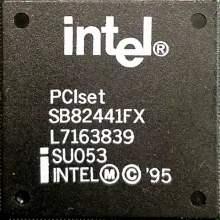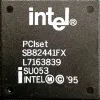
Intel 440FX (Natoma), also known as the i440FX, was a widely used chipset released by Intel in 1996. It was specifically designed for the Intel Pentium Pro and Pentium II processors, which were the leading CPUs of that era.
The i440FX chipset provided a solid foundation for high-performance desktop computers and workstations. It featured support for the Peripheral Component Interconnect (PCI) bus architecture, which allowed for faster data transfers between the CPU and peripheral devices. The chipset supported both PCI and ISA expansion slots, accommodating a wide range of add-on cards and peripherals.
One notable feature of the i440FX was its support for ECC (Error-Correcting Code) memory, which helped to detect and correct data errors in real-time. This made it a suitable choice for applications that required high reliability and data integrity, such as server environments.
The chipset also included an Advanced Configuration and Power Interface (ACPI), enabling power management and system configuration features. This allowed for more efficient energy usage and customization options for system settings.
The Intel 440FX chipset played a crucial role in the development of early Pentium-based systems and contributed to the growth of the PC industry. However, with the advancement of technology, it eventually became outdated and was replaced by newer chipsets offering better performance, enhanced features, and compatibility with newer processors. Nonetheless, the i440FX chipset remains a significant milestone in the history of Intel's chipsets, paving the way for future advancements in computer architecture.
